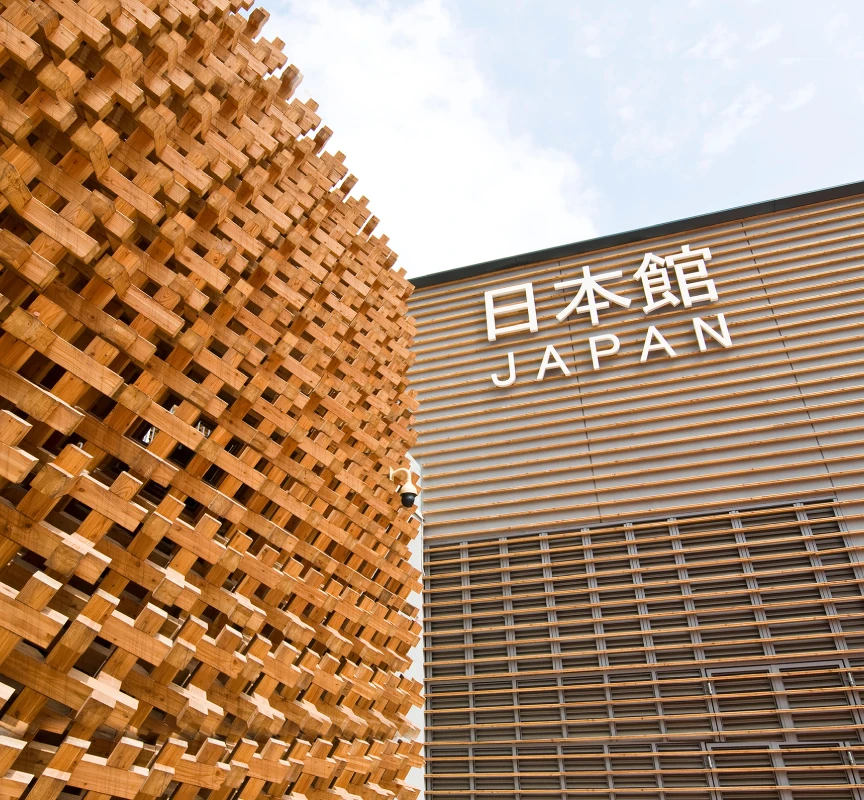- Locale
- ja
- en
History
History of the Japan Pavilion: Part 1 "Connecting With the World, Sharing With Humankind" The World Expo and Japan: 158 Years of History
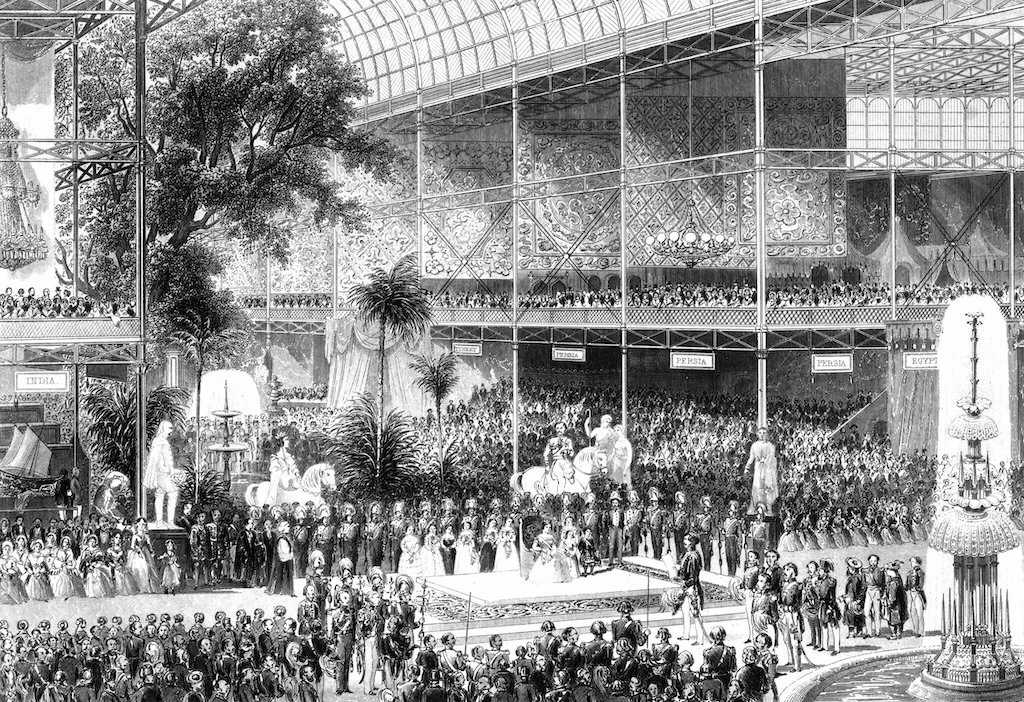
Photo by TopFoto/AFLO
Incredibly, Japan first took part in the World Expo all the way back in the Edo era (1603–1868). Records show that the second Paris Expo in 1867 featured exhibits from the Tokugawa Shogunate, alongside the Satsuma and Saga domains. Craftsmanship such as lacquerware, ceramics and paper, as well as ukiyo-e woodblock prints and other works of art were exhibited, sparking global interest in Japan.
Eiichi Shibusawa, whose portrait features on Japan's 10,000-yen banknotes newly issued in 2024, was also dispatched to the Paris Expo, and his experiences there are said to have contributed to Japan’s industrial development. In fact, the Expo and Japan share a long history. Through an investigation of Japan's experience at the World Expo, we'll explore how the country has shared culture globally.
What Is the World Expo?
The official name of the World Expo is the International Registered Exhibition. Also known as the World's Fair, the event is made possible through the participation of many countries. The World Expo is said to originate from a domestic exposition held in Paris in 1798, which was followed by individual expositions in other countries. The first truly international Expo was held in London in 1851 when a total of 25 countries participated. The event caught the public imagination, and a new style of World Expo had been born, bringing together countries from around the world.
An International Expo Finally Held in Japan!
What Exciting Future Will Japan Share With the World?
The Japanese government's first official participation in a World Expo was in 1873, in Vienna. From there, Japan continued to participate in World Expos in other countries. Almost a century later, Japan was chosen as the first Asian country to host the World Expo, for Expo 1970 Osaka.

───
●Column
The "Phantom Expo" planned before Expo 1970 Osaka
There were actually plans to hold a World Expo in Japan 30 years before Expo 1970 Osaka. It was planned to mark the 2,600-year anniversary of the founding of Japan according to the Nihon Shoki (Chronicles of Japan). The event was also to showcase Japan's recovery from the 1923 Great Kanto Earthquake. The proposed venues were the reclaimed land at Tsukishima (now Harumi) in Tokyo and Yamashita Park in Yokohama.
With a total area of 1.6 million square meters, the Expo would have been even larger than the 1.55 million square meters of the planned Expo 2025 Osaka, Kansai, Japan. Kachidoki Bridge was built as the main gateway to the Expo, attracting attention as the largest movable bridge in Asia and showcasing Japan's formidable engineering prowess. Unfortunately, however, the event was cancelled due to the outbreak of the Sino-Japanese War. The event became known as the "Phantom Expo."
───
Expo 1970 Osaka (Also Known as Expo ‘70)

Name: Expo 1970 Osaka (also known as Expo '70)
Theme: "Progress and Harmony for Mankind"
Venue: Suita, Osaka, Japan
Dates: March 15 – September 13, 1970
Site area: 330 ha
Overseas participants: 76 countries, 4 international organizations, 1 political office (Hong Kong), 3 U.S. states, 3 Canadian provinces, 2 U.S. cities, 1 German city and 2 companies
Number of visitors: approx. 64 million
Expo 1970 Osaka featured 116 exhibition halls and drew 64,218,770 visitors in total, with as many as 830,000 people visiting the Expo in a single day. For comparison, the annual number of passengers at Kansai International Airport in 2023 was approximately 25.8 million. The number of Expo 1970 Osaka visitors exceeded that figure in just six months, and there were even days when admission was restricted due to their sheer number of people. An incredible 48,139 children were reported lost and had to be found during the event! The Expo 1970 Osaka record for the largest number of visitors was unbeaten until 2010, when it was overtaken by the Shanghai Expo.
The Japan Pavilion was the largest exhibition hall at the Expo, a fitting venue for the host country. Five circular buildings, each 58 meters in diameter and 27 meters high, were designed to resemble a cherry blossom when viewed from above. The viewing course for the Japan Pavilion was around 1.2 km long and took about two hours to traverse. Visitors enjoyed large-scale exhibits (models) and videos depicting Japan's past, present and vision for the future, on the theme of "Japan and the Japanese."
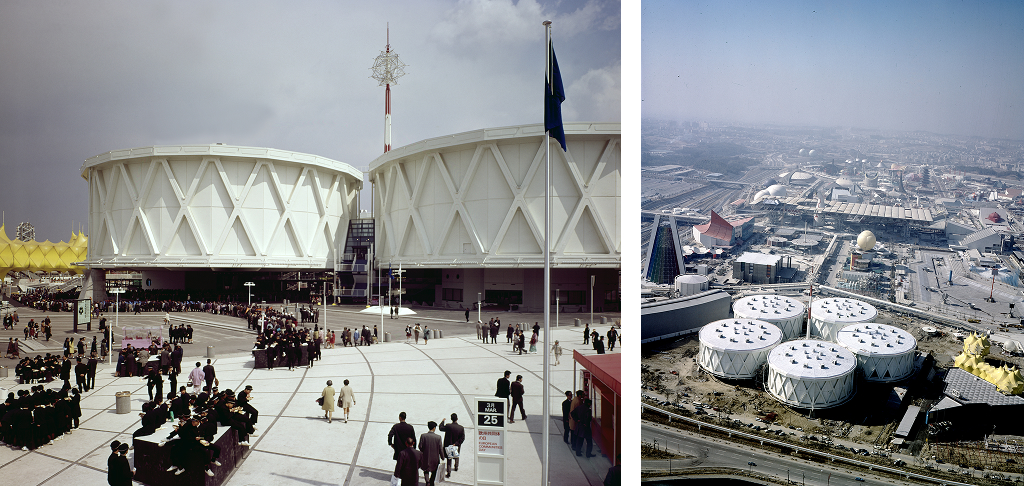
Among the many futuristic exhibits from different countries at Expo 1970 Osaka, one of the most talked-about was in the Japan Pavilion. The "Maglev Train," exhibit in Building No. 4 featured three 1/20 scale models traveling at 20 km/h on a track approximately 55 m in length, with the cars floating 10 mm above the surface. At the time, the Tokaido Shinkansen still took four hours to travel between Tokyo and Shin-Osaka stations. The Maglev Train aimed to connect Tokyo and Osaka in one hour, and its speed excited visitors about the future of transportation. Other exhibits included an Antarctic expedition, a fiberscope (fiber-optic camera) and earthquake-resistant architecture, highlighting Japan's rapid economic growth and impressing countless visitors. It is fascinating to see how many of these innovative exhibits have since become a reality, or are in the process of becoming so, proving that the World Expo can function like a time machine connecting us to the future.

A surprising exhibit in the Japan Pavillion was a collection of four small pieces of Moon rock collected by the Apollo 11 manned mission to the Moon. The rocks were a gift from U.S. President Richard Nixon to then Prime Minister Eisaku Sato and were displayed in Building No. 4 of the Japan Pavilion. The United States Pavilion had a similar exhibit of Moon rocks collected by Apollo 12.
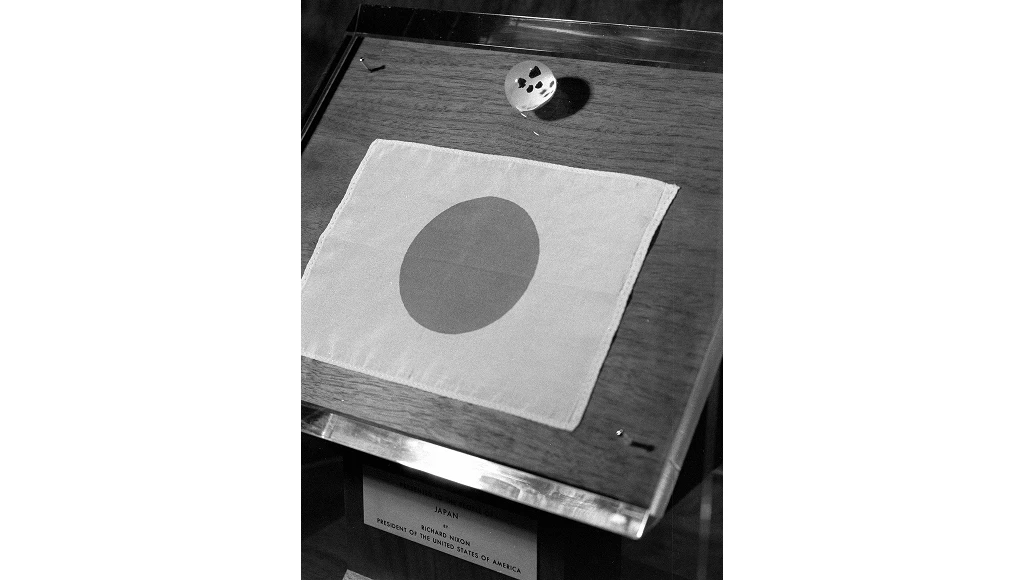
At Expo 1970 Osaka, the emphasis was on experiencing and enjoying exhibits, rather than simply viewing them. This entertainment aspect of the Expo was very important, employing a complex combination of video, modeling, equipment, sound, lighting and other elements. Japan Pavilion Building No. 5 was mostly used as a screening hall, where a video on "Japan and the Japanese" was shown on a huge 8-part split-screen 48 m wide and 16 m high. At the time, “moving pictures” were still being captured on analog film. The exhibit showcased the pinnacle of Japanese technology, including the development of a double-frame 8-lens camera used to capture the footage.
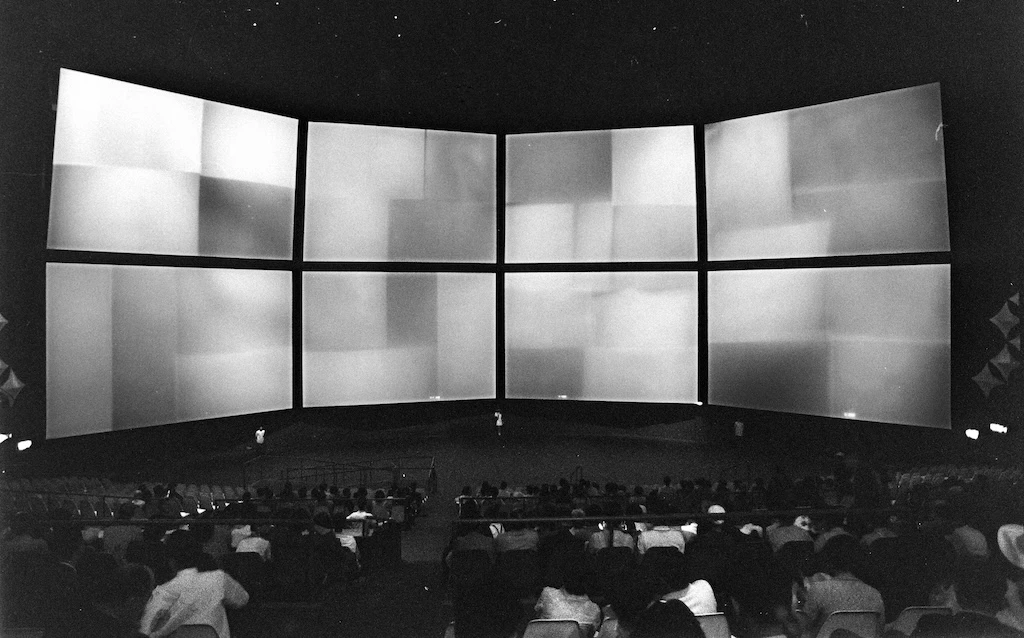
Expo 2005 Aichi, Japan (also known as Ai-chikyuhaku [lit. "Love the Earth Expo"])
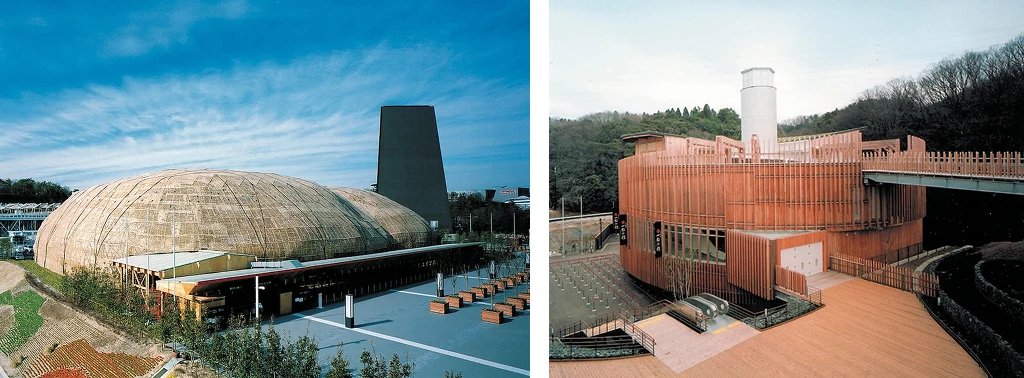
Name: Expo 2005 Aichi, Japan (also known Ai-chikyuhaku [lit. "Love the Earth Expo"])
Theme: "Nature's Wisdom"
Venue: Aichi, Japan
Dates: March 25 – September 25, 2005
Site area: Nagakute, approx. 158 ha; Seto, approx. 15 ha
Participants from overseas: 120 countries, 4 international organizations
Approx. number of visitors: 22.05 million
With Expo 2005 Aichi, Japan, the World Expo – once solely an opportunity for countries to mutually showcase their technologies and products – shifted its focus to the resolution of social issues. Expo 2005 highlighted environmental issues facing the entire planet with "Nature's Wisdom" as its theme.
The main venue was selected with an emphasis on coexistence with the natural environment, leading to the establishment of two sites: Nagakute and Seto. The Japan Pavilion was split between the Nagakute Japan Pavilion and Seto Japan Pavilion with the key message "Reconnecting People and Nature." Both pavilions were conceived as testing sites for future environmental technologies and materials, showcasing the finest examples of environmental symbiosis in that era.

The Nagakute Japan Pavilion was designed to resemble a giant bamboo enclosure, which functioned like a sudare (bamboo blind), keeping out the sun while allowing breeze in to cool the interior. The walls of the building's interior were covered with green koku mazasa (kuma bamboo grass), creating the sensation of being in a calming bamboo forest. The roof was cooled by a photocatalytic steel sheet that cleverly replicated Japan's traditional uchimizu, or water sprinkling cooling technique. This also helped reduce the burden of air conditioning inside the pavilion. In addition to using sustainable materials and products including recycled materials, a rental and lease system was used to ensure materials could be reused after the Expo. The pavilion also incorporated advanced environmental technologies to generate all the electricity needed, including renewable energy sources like solar power, biogas generated from waste and fuel cells.
The Seto Japan Pavilion was constructed using only four load-bearing pillars to support the building while minimizing changes to the natural terrain, with exterior panels installed by crane. The building achieved energy efficiency alongside symbiosis with the surrounding environment through features such as wooden exterior panels, geothermal air conditioning, solar chimneys for natural ventilation, rooftop greening and thermotropic glass.
The Japan Cyber Pavilion was established as a model for subsequent generations, where content linked to both pavilions could be viewed online. Also exhibited was "Ai MATE," a hybrid information terminal that combined a cell phone and mobile information terminal to provide support for visitors and pavilion staff. At a time when the modern smartphone didn't yet exist, this new attempt to utilize online and real-time information attracted a great deal of attention.
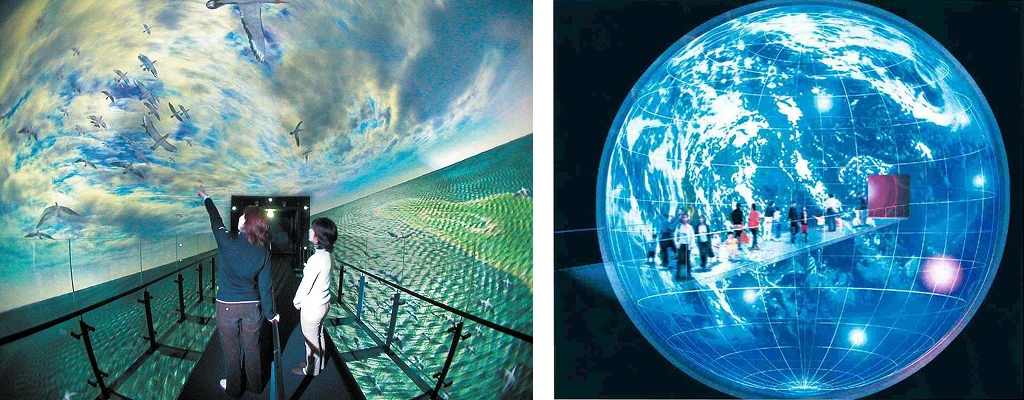
One of the most popular exhibits at the Nagakute Japan Pavilion was the "Earth Room," a 360-degree immersive video sphere. Part of its popularity stemmed from the fact it was perhaps the first time images of this nature were not enclosed in frames. The room measured 12.8 meters in diameter, one millionth of the size of the earth, and visitors could experience Earth "breathing" with their entire body as it was projected all around a transparent bridge. Here, Earth's beauty was expressed dynamically through stunning depictions of flocks of seabirds soaring in the sky, coral reefs with small fish swimming within, the sparkling, star-filled sky, and Earth as seen from outer space. This video system has since been moved to the National Museum of Nature and Science in Tokyo, where visitors can still experience it in its original form.
In the "Geospace" exhibition, guests could experience stereoscopic images visible with the naked eye without wearing 3D glasses, depicting the activity of the sun and the formation of aurora borealis.
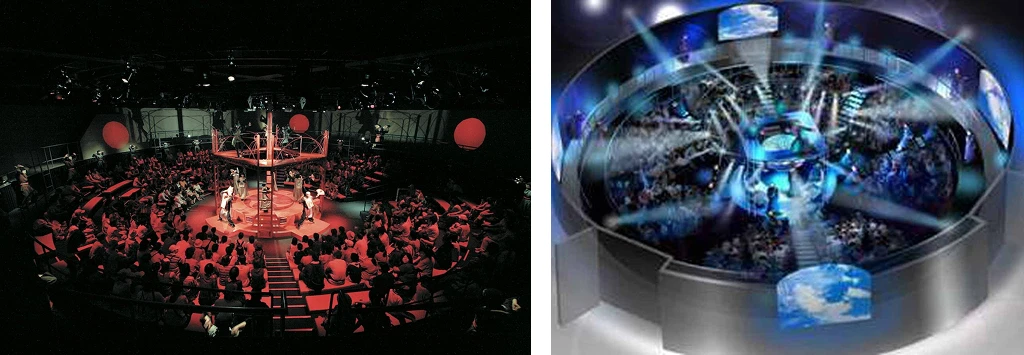
The Seto Japan Pavilion held theatrical performances daily throughout the Expo. In a circular theater, performers surrounded a seated audience, using a choral reading technique called gundoku, which blended children’s songs and calls to create a sense of togetherness. The 185-day exhibition with about 20 stage performances per day – unprecedented for a World Expo – enthralled visitors.
The Evolution of Uniforms: Trends Changing by the Minute! Japan Pavilion Uniforms in Fashion With Each Era
The uniforms of pavilion attendants are yet another highlight of World Expos. Designed to express the theme of the Expo while incorporating trends from each era, the uniforms feature illuminating details.
●Expo 1970 Osaka
With the overall theme of "Progress and Harmony for Mankind," the uniforms' design was futuristic, incorporating the then-popular mini-skirt style.
Photo courtesy of Osaka Prefectural Government
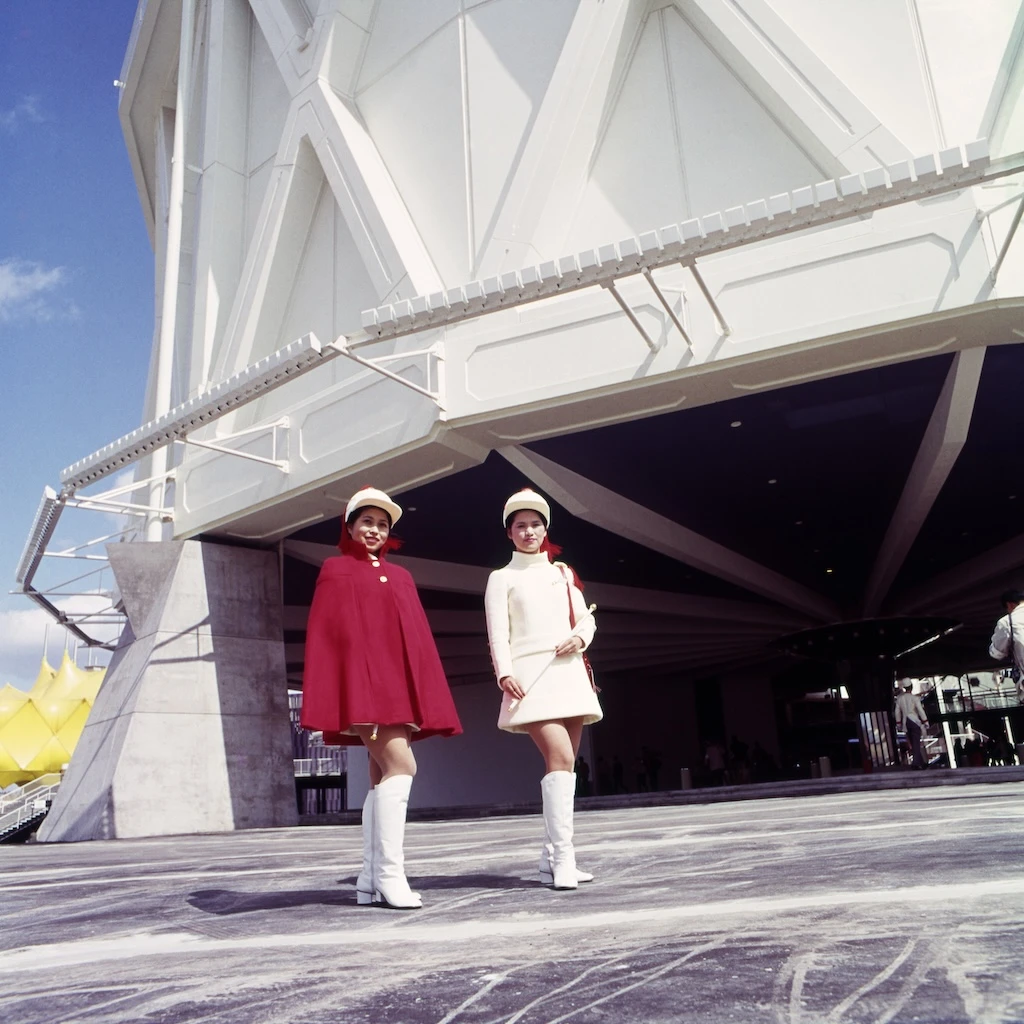
●Expo 2005 Aichi
Under the theme "Nature's Wisdom," the handmade craftsmanship Japan prides itself on was expressed in the Expo uniforms through young, fashionable trends incorporating an indigo color palette. The design was selected through a corporate competition.
Source:Ministry of Economy, Trade and Industry of Japan
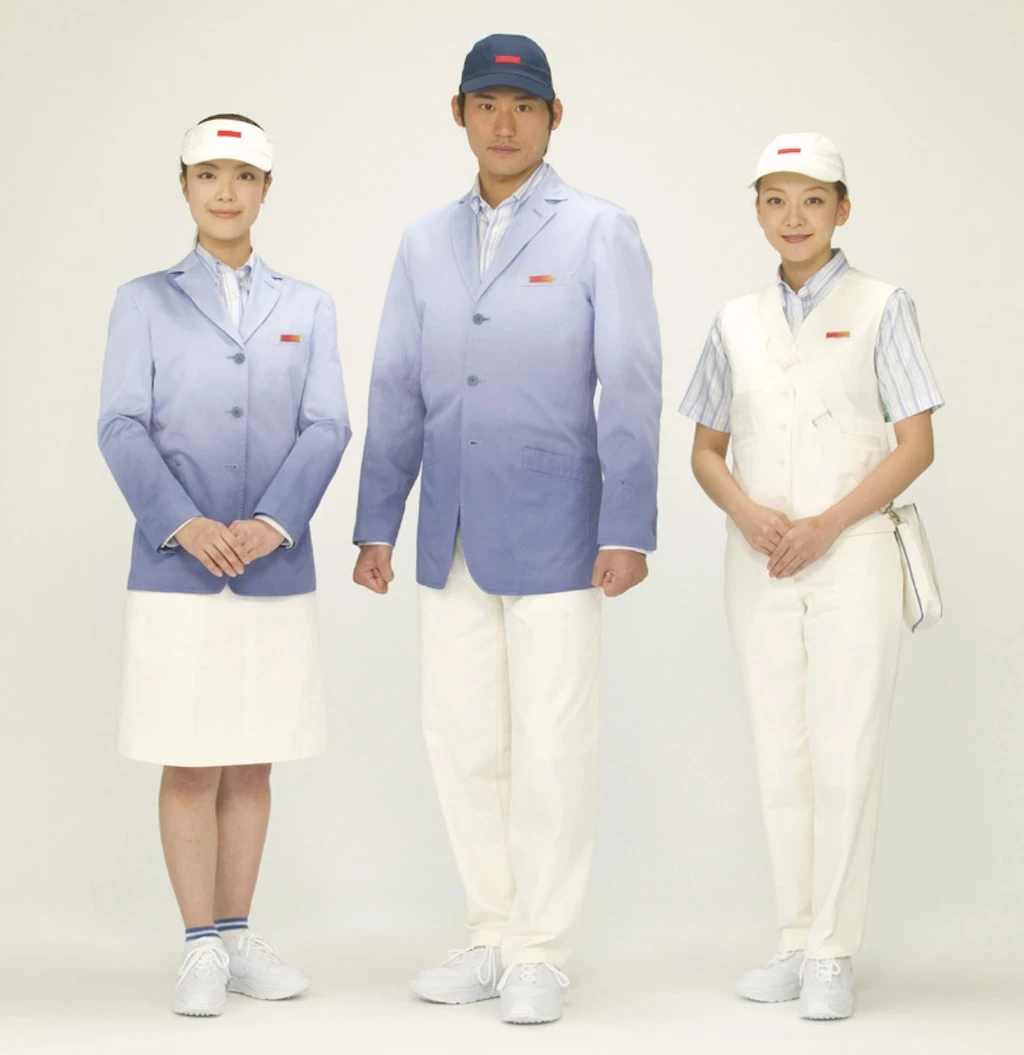
●Expo 2010 Shanghai China
Under the theme "Better City – Better Life," the design for the Expo uniforms was based on a crested ibis motif, a symbol of Sino-Japanese relations. The design was selected from among 1,600 entries in an open competition for fashion students.
Source:Ministry of Economy, Trade and Industry of Japan
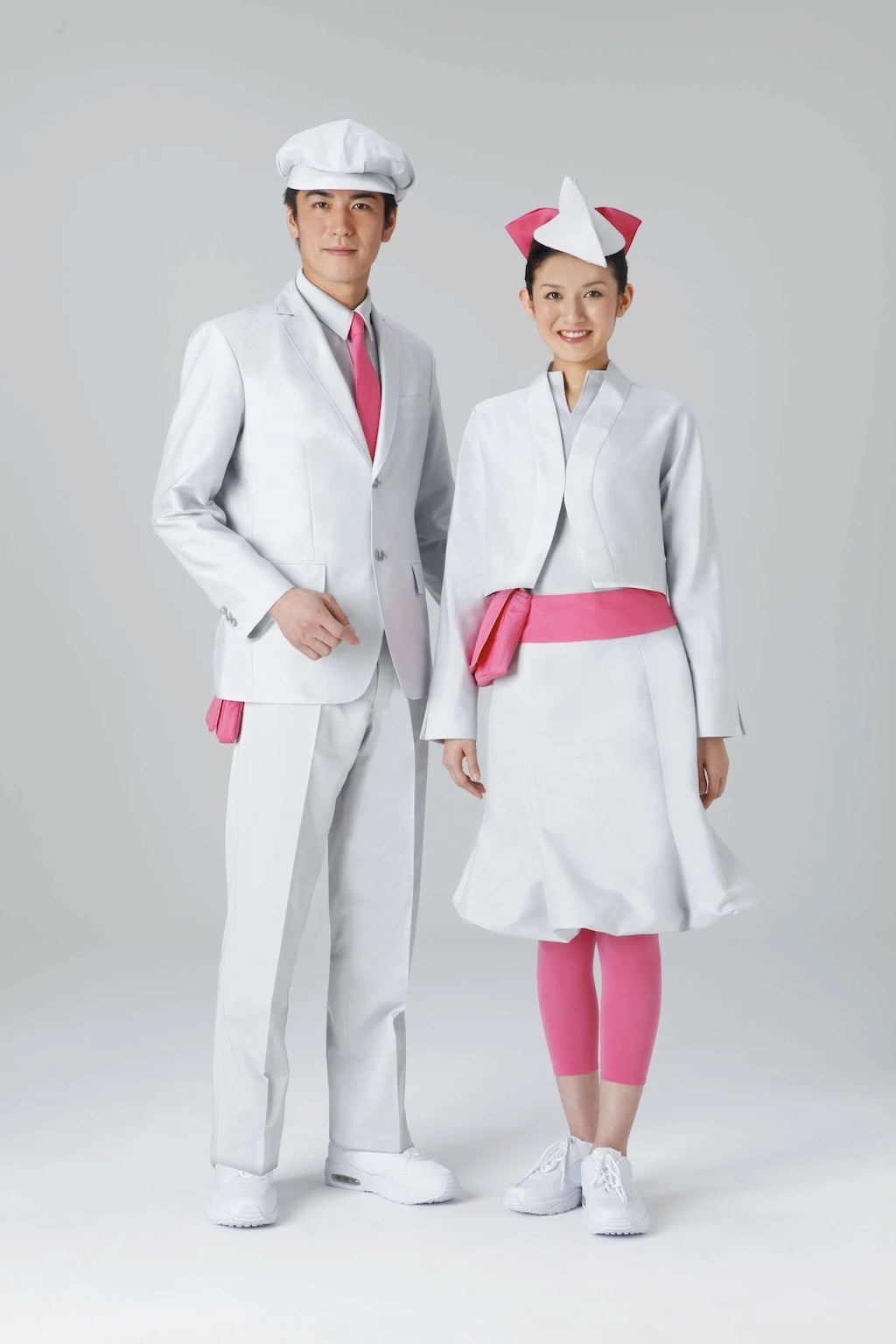
●Expo Milano 2015
Under the theme "Feeding the Planet, Energy for Life," the design for the Expo uniforms featured a single piece of cloth, similar to a kimono. The core color was red, inspired by lacquerware.
Source:Ministry of Economy, Trade and Industry of Japan
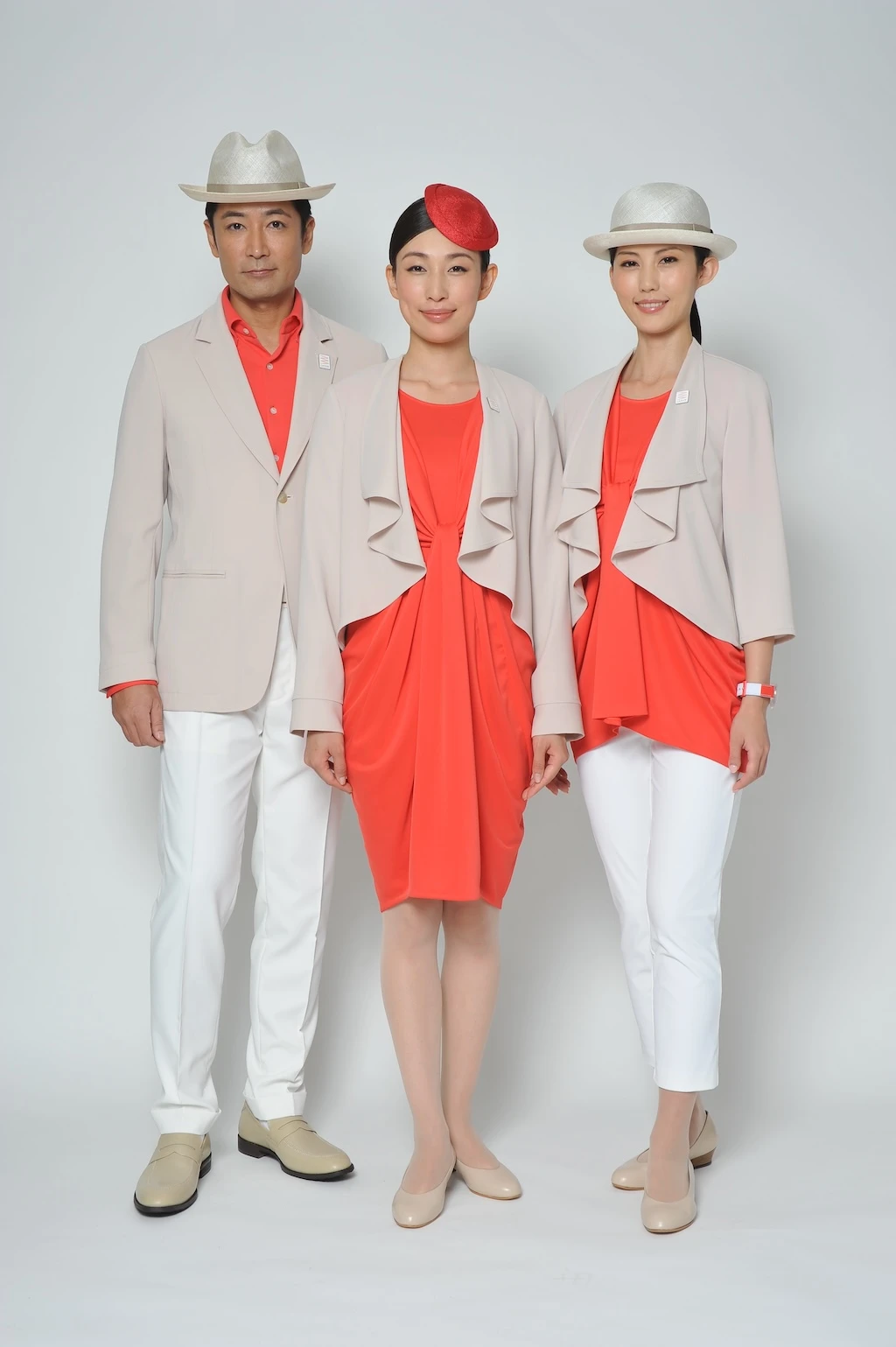
●Expo 2020 Dubai
Under the theme "Connecting Minds, Creating the Future," the designs for the Expo uniforms eliminated gender distinctions through forms designed to fit many body types. A special material was used to create patterns that emerge when exposed to light.
Source:Ministry of Economy, Trade and Industry of Japan
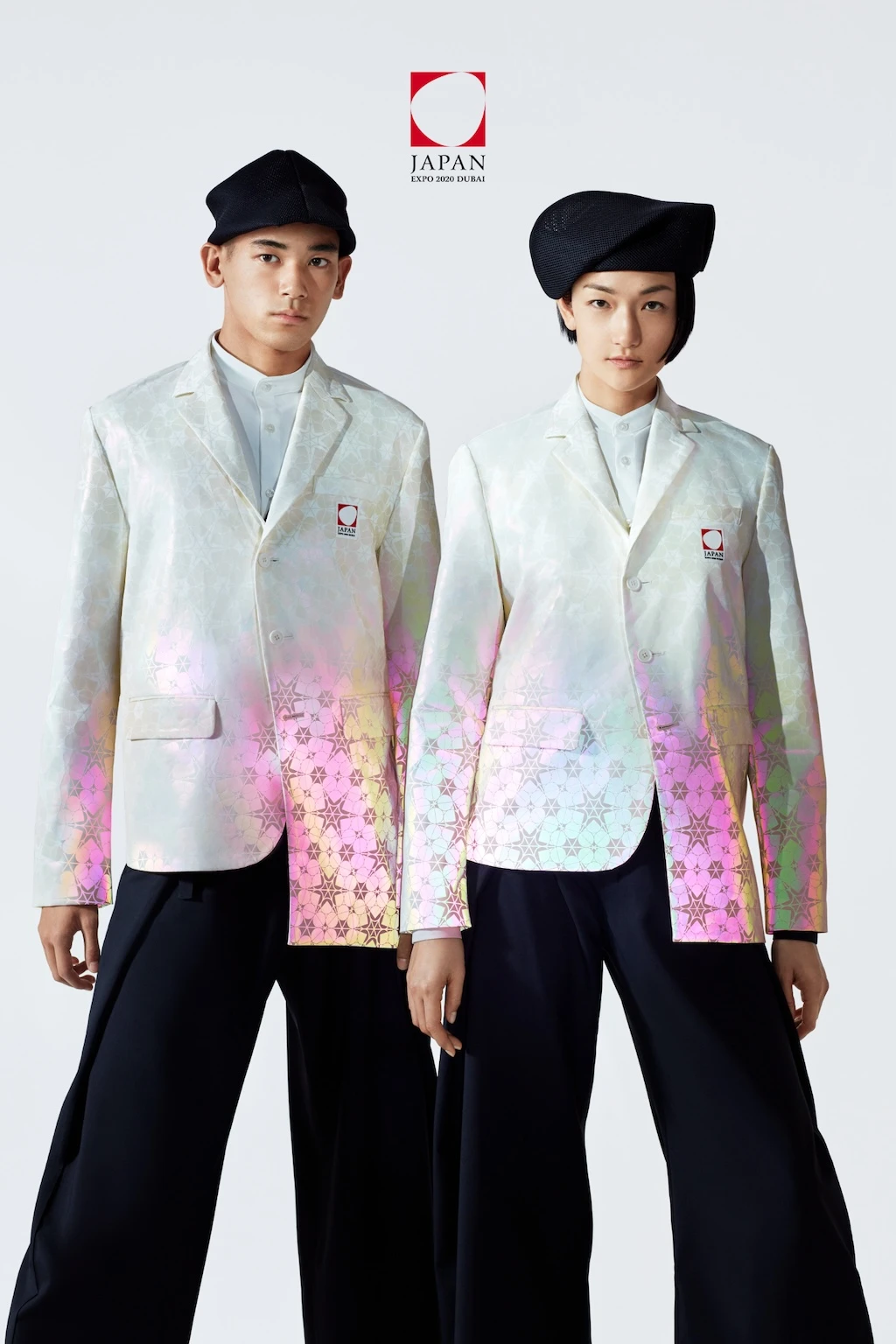
●Expo 2025 Osaka, Kansai, Japan
Under the theme "Designing Future Society for Our Lives," in addition to functionality in terms of comfort, ease of movement and protection against heat, the uniforms for this Expo have a unique design based on the concept of "embodying Japanese aesthetics."
Source:Ministry of Economy, Trade and Industry of Japan
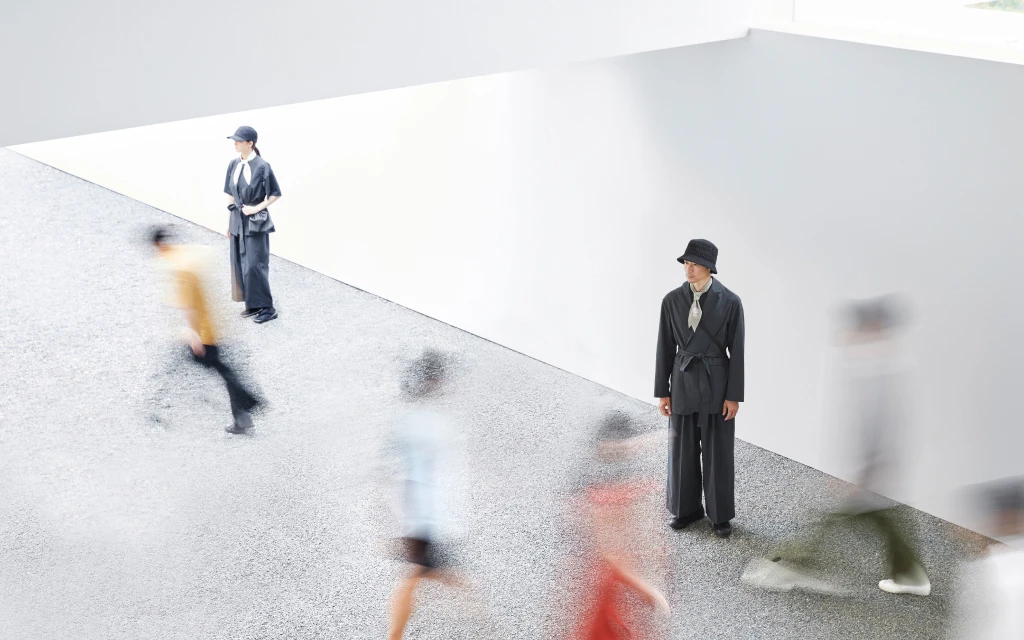
End of Part 1
The Japan Pavilions at the two previous Expos, introduced here in History of the Japan Pavilion: Part 1, were filled with passion and creativity aimed at forging a bright future, leaving a lasting impression on many. In part 2, we will introduce the Japan pavilions at the 2010 Shanghai Expo, the 2015 Milan Expo and the 2021 Dubai Expo. Please look forward to learning more!
Interview supported by Japan External Trade Organization (JETRO) / Nippon Uniform Center
Text: Yukiko Oki
Let’s Share!
Do you want to be a part of “JUNKAN”?
Share your Japan Pavilion,
and ’circulate’ your thoughts.
